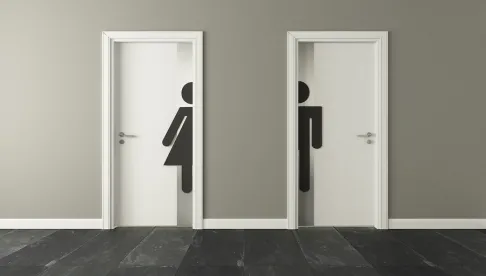California’s Equal Restroom Access Act, which requires some establishments with single-occupancy restrooms to display signs indicating that the restroom is gender-neutral, has been in effect since March 1, 2017. Assembly Bill No. 1732 (AB 1732), which Governor Jerry Brown signed on September 29, 2016, requires these restrooms “to be identified as all-gender toilet facilities” and that the signs used to designate these restrooms comply with Title 24 of the California Code of Regulations.
1. Which Restrooms Are Covered?
The new law applies to “[a]ll single-user toilet facilities in any business establishment, place of public accommodation, or state or local government agency.” AB 1732 defines “single-user toilet facility” as “a toilet facility with no more than one water closet and one urinal with a locking mechanism controlled by the user.”
2. What Does the Law Require?
The law simply requires businesses, agencies, and places of public accommodation to use the proper signage—i.e., gender-neutral signage—on any single-user restrooms that they have.
3. What Must the Sign Look Like?
The signs on single-user restrooms must comply with Title 24 of the California Code of Regulations. This means that each covered single-user restroom must, at minimum, have the following signage:
- A sign with a geometric symbol of a triangle superimposed on a circle
- A designation tactile (i.e., capable of being read by touch) sign that indicates that the facility is a restroom
4. Does the Law Require That Specific Language Be Used?
The law does not require any specific wording on the signs as long as the wording used is gender neutral. For example, the sign may state “Restroom,” “All-Gender Restroom,” “Gender-Neutral,” “Unisex,” or “All Welcome.” Similarly, language written in raised letters and/or Braille must also be gender-neutral.
Note that the City of San Francisco has more restrictive laws in place regarding the wording and images on restroom signs.
5. How Will the Law Be Enforced?
The law permits inspectors, building officials, and other local officials who are “responsible for code enforcement” to inspect a restroom for compliance with this section during “any inspection of a business or a place of public accommodation.”
Key Takeaways
Affected employers with single-occupancy restrooms on their premises should ensure that the signs on the single-user restrooms are in compliance with Title 24 of the California Code of Regulations. Employers should also take this opportunity to review the Fair Employment and Housing Council’s gender identity regulations that went into effect on July 1, 2017. The regulations’ restroom access provisions require an employer to allow an employee to use the restroom facility that corresponds to the employee’s gender identity or gender expression, regardless of the employee’s sex assigned at birth.




 />i
/>i
